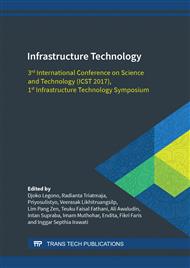p.48
p.55
p.64
p.70
p.78
p.89
p.98
p.106
p.122
Impact of Sedimentation Counter Measure on the Performance of Flood Control: A Case Study of Wonogiri Reservoir
Abstract:
The Wonogiri Reservoir with 1.343 km2 catchment area has a major problem of sedimentation. To overcome this issue, a new spillway has been built and closure dike is being constructed to localize sediment inflow from the Keduang watershed. Study on the effect of the closure and overflow dike on the reservoir operation in flood period is necessary to evaluate the performance of flood control related to the flood risk in the downstream area of the reservoir. For this purpose, the reservoir routing simulation model was developed under two condition, namely old condition and new condition with the new spillway and closure dike. The reservoir routing simulation was conducted for three inflow hydrographs of 60 and 500 years return period, and probable maximum flood (PMF). The results show that the presence of closure dike causes the peak outflow discharge increases to 1.45%, 75.18% and 56.28% for inflow hydrograph of 60 years, 500 years return period and PMF, respectively. Furthermore, the maximum water level also increases by 0.3 m, 1.9 m and 0.9 m for those three new design floods respectively. In order to reduce the dam overtopping failure chance of the 500 years return period flood, it is recommended to operate full opening of the new spillway gate when the water level reaches elevation +135.6 m MSL.
Info:
Periodical:
Pages:
78-85
Citation:
Online since:
May 2018
Price:
Сopyright:
© 2018 Trans Tech Publications Ltd. All Rights Reserved
Share:
Citation:


